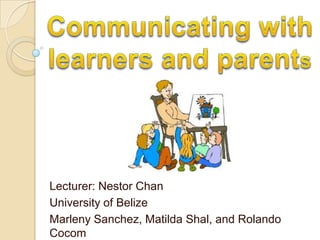
Communicating with learners and parents
- 1. Communicating with learners and parents Lecturer: Nestor Chan University of Belize MarlenySanchez, Matilda Shal, and Rolando Cocom
- 2. Content: What is communication The triad concept Effective communication Delivery Class participation Strategies Negative communication Parent involvement Conclusion
- 4. everyone who is part of the conversation
- 6. assessment, method, and sample
- 8. grades, ratings, checkmarks, percentages, smiley faces, etc.
- 9. Communication tailored to the audience
- 11. Class Participation Daily review: “I learnt…” Clarify points of confusion New material: main points and examples. Specific feedback- Correct/incorrect answers to questions are acknowledged. Cooperative learning Accepts feelings in a non-threatening manner.
- 12. Class Participation Praises or encouragements: Give kudos to student’s efforts. Make jokes that release tension, but not at the expense of another individual. Accept or use ideas of pupils: clarify, or develop ideas suggested by a student. Ask questions: Ask question first then call on someone to answer. A lower-order question and higher-order question. Recall then reasoning.
- 14. Helpful Strategies: Address students as equals. Listen to students and their responses. Pair students or small groups Display genuine attention and interest; going the “extra mile” Role reversal: they become the experts and source of knowledge Allow them to talk about themselves. (Affective domain)
- 15. Helpful Strategies: Give constant appraisals. Feed their ideas. Be friendly and courteous. Respect diversity. Content knowledge Have patience. Conducive learning environment Authentic resources
- 16. Negative Communication Stern discipline Strict conformity to regulations Setting unattainable standards Emotional outbursts Sarcasm Excessive home works and assignments Recurrent low grades These may lead to frustration, poorly prepared assignments, inability directions, careless work, and overall dislike of teacher and school.
- 18. Involving Parents Letting the parents know: Where we are going. Where we are. How to close the gap. Teachers must have good intentions to collaborate with parents. Clear information on all school policies, academic programs, and transitions (Michael, Diana, 2001) Effective newsletters about school events, student activities, and parent’s questions and reactions
- 19. Involving Parents Teachers should create opportunities to participate in the education efforts of the school. Conferences with every parent -with follow-ups as needed Folders of student work sent home regularly for parent review and comments Give parents invitations through notes written by pupils or formal announcements to meet with parents.
- 20. Involving Parents Meeting once with parents is rarely enough to get consistent behavior on either part of parents or a child. Parents must know the objectives of education, activities, and assignments. Perception and attitudes: Teacher ego: I know best, I… Friends and fellow workers.
- 21. Involving Parents Engagement in learning actives at home: homework help, projects Guidelines of parents involvement Objectives of lessons, and assessments Workshops for parents: discipline, drug abuse prevention, assessment aid, internet How many parents feel capable to help their children? Support groups Sharing parenting tips Social gatherings Home visiting programs Parents should know in what areas they can help their children.
- 22. Conclusion: The teacher’s principal role is to transmit knowledge to students. To do so, the teacher must communicate effectively in order to facilitate learning. There is a need to establish and maintain good personal relationships with students and parents.
- 23. Reference: Coleman, Peter. (1998). Parent, student and teacher collaboration: the power of three. London, UK: Corwin Press Inc. Chamberlain, Leo M., and KindredLeslie W. (1996). The teacher and school organizations. Englewood cliffs, NJ: Prentice-Hall Hoy Wayne, and Miskel Cecil, (2004). Educational leadership and reform. United States. Information Publishing Inc. Michael, Diana. (2001). Promising practices for family involvement in schools. United States. Information Publishing Inc. Stiggins, R., Arter, J., Chappuis, J., & Chappuis, S. (2007). Classroom assessment for student learning: Doing it right – using it well. Upper Saddle River, NJ: Pearson Prentice Hall.
Notes de l'éditeur
- Rolando: What is communication The triad concept Effective communication DeliveryMarleny Class participation Strategies Negative communicationMatilda Parent involvement Conclusion